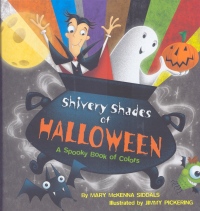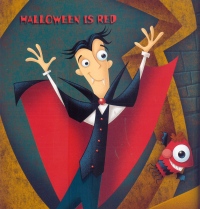| ________________
CM . . .
. Volume XXI Number 9 . . . . October 31, 2014
excerpt:
Shivery Shades of Halloween: A Spooky Book of Colors is a playful way for young readers to engage with multiple types of literacy. BC-based author Mary McKenna Siddals is a former teacher and has written a number of picture books. Her teaching background clearly influences her skill in making language descriptive and fun. For this newest offering, she has partnered with illustrator Jimmy Pickering whose diverse artistic practice draws heavily from the world of computer animation. Using Halloween as a thematic framework, Siddals and Pickering guide young readers in expanding their vocabularies in a playful way. Pickering’s illustrations show the objects from Siddal’s poems so that young readers are able to draw connections between spoken word, written word and picture. The featured colour is highlighted prominently on each spread to help emphasize the theme of the book. Due to the Halloween theme, Pickering’s aesthetic seems to reference the style of Tim Burton; however, Pickering’s illustrations make use of a brighter colour palette which will catch the attention of young readers. The figures in each illustration are depicted in dynamic poses: a wizard casts a spell as a fortune-teller peers into her crystal ball (pp. 10-11). For continuity, there is a small creature that appears on each spread so that young readers can track him throughout the book, his colour changes depending on the featured colour. Shivery Shades of Halloween provides a colourful way for young readers to explore new vocabulary. Although using a Halloween theme to frame basic literacies is not particularly innovative, this book is charming and would be great for one-on-one reading between adult and child. The lack of a narrative would make it challenging for a larger group, such as a preschool storytime. Pickering’s bright and lively illustrations are key in making this book appropriate for young readers ages 4-6. Together with Siddals’ playful prose, this makes Shivery Shades of Halloween a great addition to any library’s Halloween collection. Recommended. Sabrina Wong is a librarian at the University of Calgary in Calgary, AB.
To comment on this title or this review, send mail to cm@umanitoba.ca.
Copyright © the Manitoba Library Association. Reproduction for personal use is permitted only if this copyright notice is maintained. Any
other reproduction is prohibited without permission.
CM Home | Next Review | Table of Contents for This Issue - October 31, 2014 | Back Issues | Search | CM Archive | Profiles Archive |

 The book opens with the question “What colour is Halloween?” (p. 1). As the reader progresses through the book, each spread offers a case for a different colour, culminating in a summary of all the “shivery shades of Halloween” (p. 23). Siddals reaffirms the young reader’s existing knowledge of colours and provides new associations with the Halloween theme. Shivery Shades of Halloween is especially appealing to young readers who have advanced beyond simple colour-object associations such as “apples are red”. The book gives colour action, shape and texture: “Bloody-ruddy, burning-churning, blushing-gushing/ Stain of red” (p. 19). The book’s playful use of rhyme and rhythm emphasizes the fun and creative aspect of language. Siddals uses recombined and imagined words such as “glowy-showy” and “shiny-tiny” to make prose more accessible. This focus on expression rather than using proper words empowers young children by mimicking their use of made-up words and by legitimizing the process of experimentation as they acquire vocabulary. That is not to say that the book is written entirely in nonsense words; Siddals uses a combination of real and nonsense words to draw on different sensory experiences of colour. Each colour is given an illustrative spread and two chunks of text: one poem with short lines that refers to objects of that colour and a second passage with descriptive nonsense words. The meter of the poem varies, but many lines conform to iambic rhythms which makes the poem easy to read aloud to young children.
The book opens with the question “What colour is Halloween?” (p. 1). As the reader progresses through the book, each spread offers a case for a different colour, culminating in a summary of all the “shivery shades of Halloween” (p. 23). Siddals reaffirms the young reader’s existing knowledge of colours and provides new associations with the Halloween theme. Shivery Shades of Halloween is especially appealing to young readers who have advanced beyond simple colour-object associations such as “apples are red”. The book gives colour action, shape and texture: “Bloody-ruddy, burning-churning, blushing-gushing/ Stain of red” (p. 19). The book’s playful use of rhyme and rhythm emphasizes the fun and creative aspect of language. Siddals uses recombined and imagined words such as “glowy-showy” and “shiny-tiny” to make prose more accessible. This focus on expression rather than using proper words empowers young children by mimicking their use of made-up words and by legitimizing the process of experimentation as they acquire vocabulary. That is not to say that the book is written entirely in nonsense words; Siddals uses a combination of real and nonsense words to draw on different sensory experiences of colour. Each colour is given an illustrative spread and two chunks of text: one poem with short lines that refers to objects of that colour and a second passage with descriptive nonsense words. The meter of the poem varies, but many lines conform to iambic rhythms which makes the poem easy to read aloud to young children.